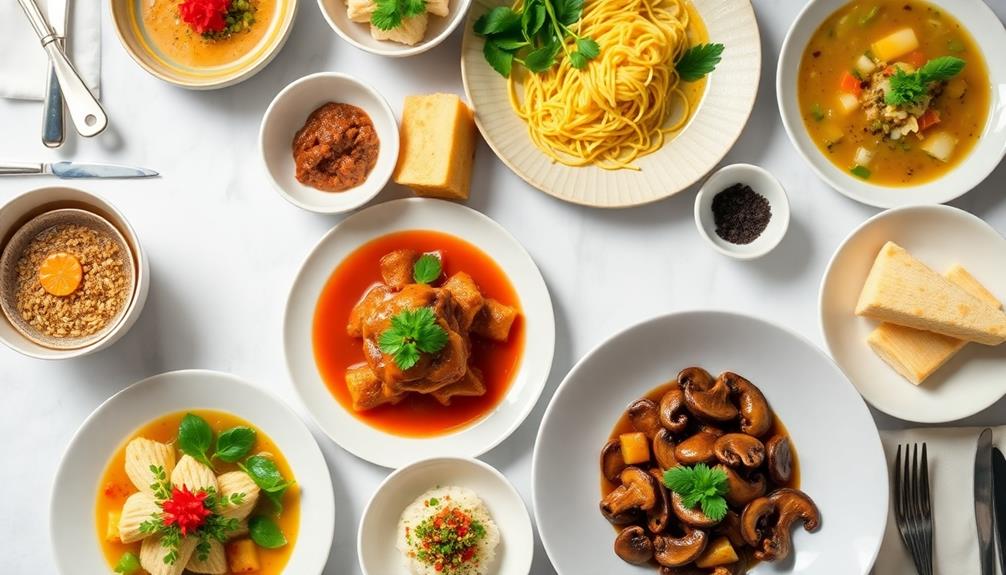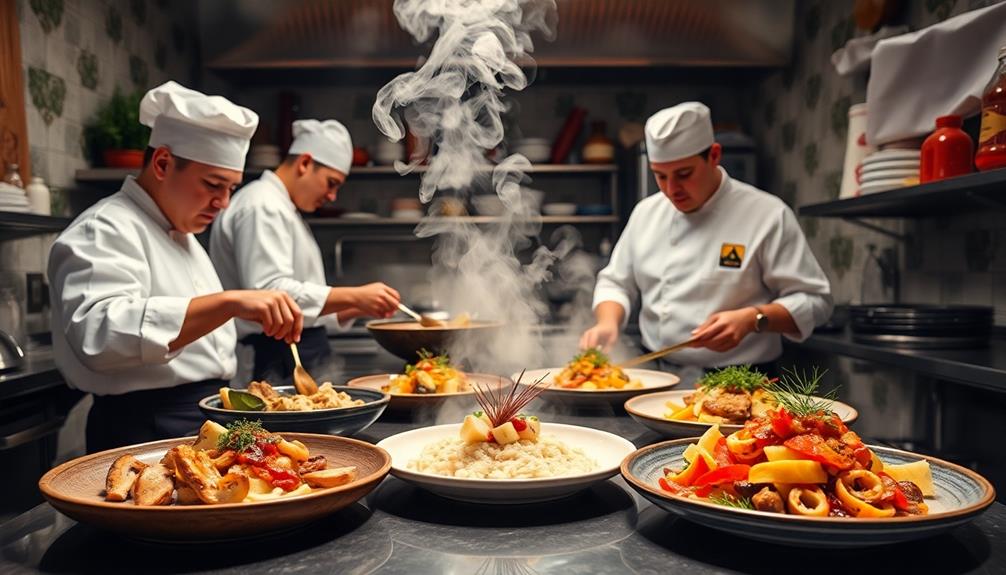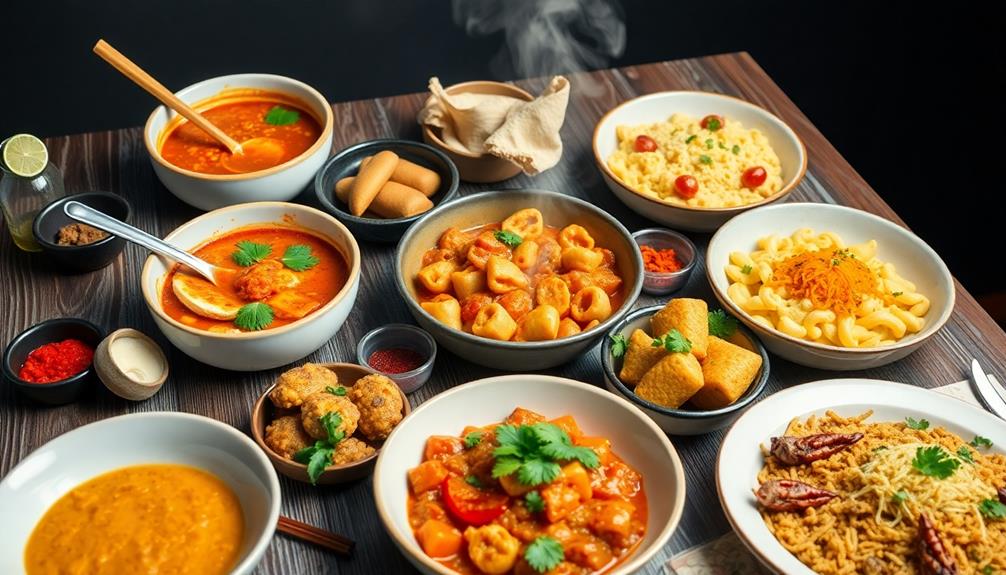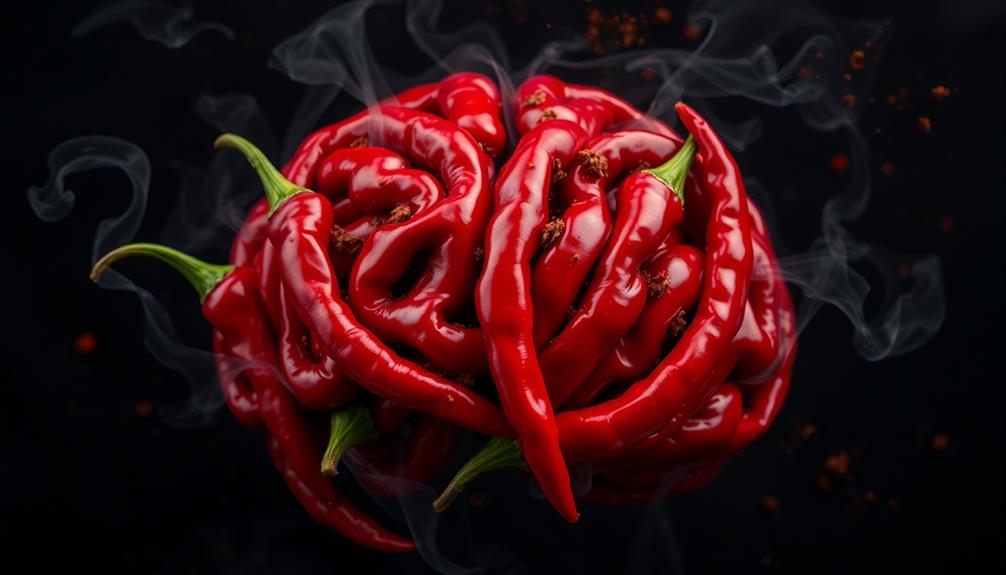Umami is the tasty, savory flavor that chefs adore! It was discovered over a century ago and quickly became a superstar in fine dining. Here's why you should get excited about it:
- It enhances flavors without extra salt.
- You'll find it in yummy foods like soy sauce, aged cheeses, and mushrooms.
- Chefs mix umami ingredients to create fun and unique dishes, even in desserts!
- Millennial diners are crazy for umami, making it a sought-after choice.
So, next time you enjoy a delicious meal, you might just be savoring the magic of umami that everyone's talking about!
Key Takeaways
- Umami, recognized as the fifth primary taste, enhances savory dishes and creates a balanced dining experience in fine dining.
- The global adoption of umami-rich ingredients, like miso and aged cheeses, has influenced culinary fusion and innovative dishes.
- Celebrity chefs prominently feature umami in their creations, using traditional techniques and ingredients to elevate flavor profiles.
- Health benefits associated with umami, such as reduced sodium intake and improved satiety, contribute to its rising popularity in dining.
- Millennials show a growing interest in umami flavors, driving trends towards more savory and umami-enhanced dishes in restaurants.
The Origins of Umami

In the early 20th century, a groundbreaking discovery reshaped our understanding of flavor: umami. This delightful, savory taste was first identified in 1908 by Japanese scientist Kikunae Ikeda. While studying dashi broth made from kombu, he noticed a flavor that wasn't explained by the usual sweet, sour, salty, or bitter tastes. He named this new flavor "umami," which means "pleasant savory taste" in Japanese.
This concept is also reflected in traditional Japanese dishes like Dorayaki (Red Bean Pancake), where the balance of flavors showcases the essence of umami.
Umami is special because it comes from certain amino acids, especially glutamate. You might find umami in many tasty foods, like:
- Fermented products such as soy sauce and miso
- Aged cheeses like Parmigiano-Reggiano
- Natural ingredients like tomatoes and mushrooms
In Japanese cuisine, umami plays a huge role. It enhances dishes and helps you appreciate the wonderful flavors of natural ingredients.
Thanks to Kikunae Ikeda, we now understand why some foods taste so good!
It wasn't until 2000 that scientists officially recognized umami as the fifth primary taste. So, the next time you enjoy a delicious meal, remember that umami adds that magical touch to your favorite flavors!
Characteristics of Umami Flavor

Umami flavor stands out as the fifth basic taste, enchanting your palate with its savory, meaty essence. It's like a warm hug for your taste buds! This delightful flavor comes from amino acids, particularly glutamate, and it can truly elevate your meals. When you enjoy umami-rich foods, they create a lingering, mouth-filling sensation that makes dishes extra delicious.
Here's a quick look at some common umami-rich foods:
| Umami-Rich Foods | Description |
|---|---|
| Soy Sauce | A fermented sauce that's salty and savory. |
| Parmigiano-Reggiano | Aged cheese with a rich, nutty flavor. |
| Tomatoes | Juicy and tangy, perfect for sauces. |
| Shiitake Mushrooms | Earthy and meaty, great in stir-fries. |
Umami isn't just tasty; it can also help you eat healthier! By enhancing flavor, it reduces the need for extra salt, making your meals both flavorful and balanced. So, next time you savor a delicious dish, remember you're enjoying the magic of umami—the fifth taste that brings joy to your plate!
Umami in Japanese Cuisine

When you think about Japanese cuisine, dashi stands out as a superstar! This delicious broth, made from kombu and bonito flakes, brings a warm umami flavor to your favorite dishes.
The incorporation of fermented ingredients, such as miso and soy sauce, is reminiscent of the fermentation techniques seen in Korean dishes like kimchi, adding even more depth and complexity to the flavor profile, making every bite a delightful experience for your taste buds!
Dashi's Essential Role
Dashi stands out as a cornerstone of Japanese cuisine, infusing dishes with its rich umami flavor. This amazing broth is made by steeping dried kombu in water and then adding katsuobushi flakes. The result? A clear and fragrant liquid that gives your meals an authentic Japanese touch!
Here's a quick look at dashi's essential elements:
| Ingredient | Flavor Contribution |
|---|---|
| Kombu | Releases glutamate, adding umami |
| Katsuobushi | Adds depth and richness |
| Water | Forms the base of the broth |
| Time | Quick to prepare, enhancing efficiency |
Dashi is a game-changer! It enhances soups, sauces, and marinades, making them burst with flavor. The secret lies in its primary ingredient, glutamate, which is released during the steeping process. By mastering dashi, you can elevate your cooking and delight your family with the true essence of Japanese flavor.
Fermentation Techniques Impact
Japanese cuisine thrives on the rich flavors created by fermentation techniques, which transform simple ingredients into umami-packed staples. These techniques are essential for developing that delicious umami flavor you love.
For example, when making miso and soy sauce, fermentation breaks down proteins into tasty glutamates. Additionally, fermentation plays a significant role in various cuisines around the world, including traditional Chinese dishes like Red-Braised Pork Belly, which also showcase deep and complex flavors. In fact, the use of fermentation is just one of many techniques employed to enhance the depth of flavors in cooking. Another example is the use of copper cookware and flavor enhancement, as copper provides excellent heat conductivity, allowing chefs to precisely control cooking temperatures for optimal flavor release. Combining these time-honored methods results in dishes with rich, layered tastes that continue to excite palates across different culinary traditions.
Here are some key points about fermentation's impact on umami:
- Dashi: This fundamental broth combines fermented ingredients like kombu and katsuobushi, showcasing the synergistic effect that fermentation has on flavor.
- Amino Acids: The fermentation process releases amino acids and nucleotides, producing complex flavors that elevate your favorite dishes.
- Koji Mold: Traditional Japanese methods, like using koji mold, create umami-rich ingredients such as sake and miso, forming the backbone of many recipes.
The historical significance of fermentation in Japan shows a cultural emphasis on umami. Dishes are carefully balanced to create a harmonious flavor experience.
Global Adoption of Umami

Umami isn't just for sushi anymore; it's making its way onto plates all around the world!
You'll find chefs mixing ingredients like miso and aged cheese, creating exciting new flavors that everyone loves.
In Mexican cuisine, umami-rich dishes like chilaquiles and cochinita pibil showcase how diverse ingredients can elevate a meal.
As more people discover the joy of umami, it's becoming a star at both casual and fancy restaurants, promising delicious experiences for all!
Culinary Fusion Trends
In recent years, the culinary world has embraced umami as a key player in fine dining, leading to exciting fusion trends that blend traditional and contemporary flavors.
You'll find that chefs are creatively mixing umami-rich ingredients like miso and soy sauce with Western culinary techniques. This means you can enjoy dishes that tickle your taste buds in new ways! For instance, the rich flavors found in Indian dishes like Mushroom Masala can complement umami elements beautifully, creating a harmonious dining experience.
Here are some delightful fusion dishes you might encounter:
- Miso butterscotch desserts: Sweet and savory all in one bite!
- Savory ice creams: Who knew ice cream could be so bold and flavorful?
Restaurants like Umami Burger have also jumped on the umami bandwagon, offering menus that focus on this savory flavor. They combine unique ingredients to create meals that are simply unforgettable.
And don't forget about culinary events! Umami-focused dinners and tastings are popping up everywhere, giving you a chance to explore this delicious flavor in fine dining settings.
With all these exciting trends, umami is making every meal a delightful adventure for food lovers of all ages! So, get ready to savor the magic of umami in your next dining experience!
Global Ingredient Exploration
Around the world, chefs are increasingly embracing umami as an essential flavor component, transforming the culinary landscape. This savory taste, known as one of the primary tastes, is popping up in kitchens everywhere.
You might find umami in delicious dishes from Japan, Italy, and Thailand, where ingredients like miso, soy sauce, and fish sauce are stars of the show. Additionally, Brazilian cuisine showcases umami through its diverse seafood dishes, such as Caldeirada, which highlight rich flavors and ingredients.
Here are some exciting ways umami is making waves in the food industry:
- Global Ingredients: Miso and soy sauce from Japan, Parmigiano-Reggiano from Italy, and Thai fish sauce have become staples in many recipes.
- Western Cuisine: Chefs are using mushrooms, tomatoes, and fermented foods to add that extra kick of flavor, making meals more exciting.
- Millennial Interest: Did you know over half of millennials are keen on umami flavors? This shows a growing demand for savory dishes that delight the taste buds!
- Unique Menus: Restaurants like Umami Burger and Umami Sushi create mouthwatering menus that feature umami-heavy dishes, perfect for family outings.
Health Benefits of Umami

The rich flavor profile of umami not only elevates the dining experience but also offers several health benefits that can enhance your overall well-being.
When you enjoy food with umami, you're likely to taste more delicious flavors, which can make healthy foods like vegetables and whole grains more appealing. This encourages you to eat a balanced diet! For example, dishes like Nettle and Potato Soup showcase how umami can be integrated with fresh, nutritious ingredients, enhancing both flavor and health benefits.
Here are some amazing health benefits of umami:
- Stimulates Appetite: Umami can make your meals tastier, helping those with reduced appetite, like after an illness, enjoy food again.
- Lower Sodium Intake: Using umami flavors allows you to reduce salt in your dishes, promoting better heart health while keeping great taste.
- Improves Fullness: Umami can help you feel full and satisfied, which can be helpful for weight management or preventing obesity.
- Nutrient-Rich: Foods high in umami often contain proteins and vitamins, giving your body the nutrients it needs.
Culinary Techniques for Umami

Five essential culinary techniques can transform your dishes by enhancing umami flavors.
Let's explore the world of umami and make your meals unforgettable! For instance, incorporating ingredients like Kue Putu, which features coconut and palm sugar, can add a delightful sweetness that complements umami-rich dishes.
1. Fermentation: This magical process breaks down proteins, releasing glutamates.
Think of delicious fermented fish sauces that pack a flavorful punch!
2. Using Shiitake Mushrooms: These mushrooms are nature's umami boosters.
They add a rich, savory taste that makes your dishes sing.
3. Making Dashi: This traditional Japanese broth, made with kombu and bonito flakes, is a quick way to infuse umami into soups and sauces without long cooking times.
4. Aging Ingredients: Cheeses and meats develop deeper flavors over time.
Aged cheeses can add a creamy, savory touch to your favorite recipes.
5. Innovative Cooking Methods: Techniques like sous-vide let you control temperatures precisely, helping you extract maximum umami from every ingredient.
Celebrity Chefs Embracing Umami

In recent years, celebrity chefs have taken umami to new heights, transforming how we experience flavor in fine dining. Chefs like Heston Blumenthal are leading the way by using traditional Japanese ingredients, such as miso and dashi, to create amazing flavor profiles.
Additionally, the use of rich ingredients found in Italian cuisine like aged cheeses and savory sauces enhances umami experiences. David Chang, known for his Momofuku restaurants, brings umami to the forefront with fermented goodies like soy sauce and fish sauce, making dishes that burst with savory goodness.
It's not just about the food; it's about the experience! At places like Umami Burger, you'll find chefs blending umami-rich ingredients in creative ways that excite your taste buds.
Thomas Keller also emphasizes umami by using aged cheeses and mushrooms, showcasing how versatile this flavor can be.
Here's how celebrity chefs are making umami a star:
- Innovative Ingredients: They incorporate high-umami items.
- Fermentation Techniques: They experiment to create unique flavor enhancers.
- Exciting Dishes: They craft meals that redefine fine dining.
Future Trends in Umami Usage

As celebrity chefs embrace umami, the culinary landscape is shifting towards exciting future trends that promise to elevate this savory flavor even further.
You'll see more chefs using fermentation techniques like koji and lacto-fermentation to create umami-rich ingredients. These methods not only add flavor but also promote sustainability, which is great for our planet!
Additionally, as chefs explore the rich flavors of global cuisines, dishes like Muamba De Galinha highlight how traditional ingredients can enhance umami experiences.
Here are some trends to keep an eye on:
- Umami-enhanced Products: More restaurants are serving plant-based dishes that replicate umami flavors. This offers tasty, sustainable alternatives that everyone can enjoy.
- Health Benefits: Research shows that umami can help reduce sodium intake and keep you feeling full. This means healthier choices when dining out!
- Collaborative Dining: As restaurants experiment with umami, you might find unique pairings and dishes that celebrate this savory taste, making dining more exciting.
- Millennial Interest: Over half of millennials are keen to try umami-rich foods, showing that this flavor is definitely trending!
Frequently Asked Questions
When Did Umami Become an Official Taste?
Umami officially became recognized as a distinct taste in 2000 when researchers confirmed specific glutamate receptors on the tongue. This acknowledgment transformed how you experience and appreciate savory flavors in your culinary adventures.
Why Did Savory Become Umami?
You're savoring a rich broth, the deep, savory notes enticing your taste buds. Over time, you realize this unique deliciousness, enhanced by glutamate and amino acids, transforms ordinary flavors into umami—an unforgettable culinary experience.
What Makes Umami Flavor?
Umami flavor comes from compounds like glutamate, nucleotides, and certain amino acids. When you taste foods like mushrooms, tomatoes, or aged cheeses, you're experiencing that savory, satisfying depth that makes dishes truly enjoyable.
What Chemical Is Responsible for Umami Flavor?
Imagine savoring a perfectly cooked steak; that rich, savory taste comes from glutamate. This amino acid, along with nucleotides like inosinate, creates umami, enhancing your meals and tantalizing your taste buds in every bite.
Conclusion
Umami's journey from a hidden gem in Japanese kitchens to a star in fine dining is truly exciting! Just like a rainbow after a storm, its rich, savory flavor brightens up every dish. As you explore new recipes, think of umami as your secret ingredient, making meals more delicious for everyone at the table. So, gather your family and immerse yourself in the world of umami, where every bite is a celebration of flavor and joy!










